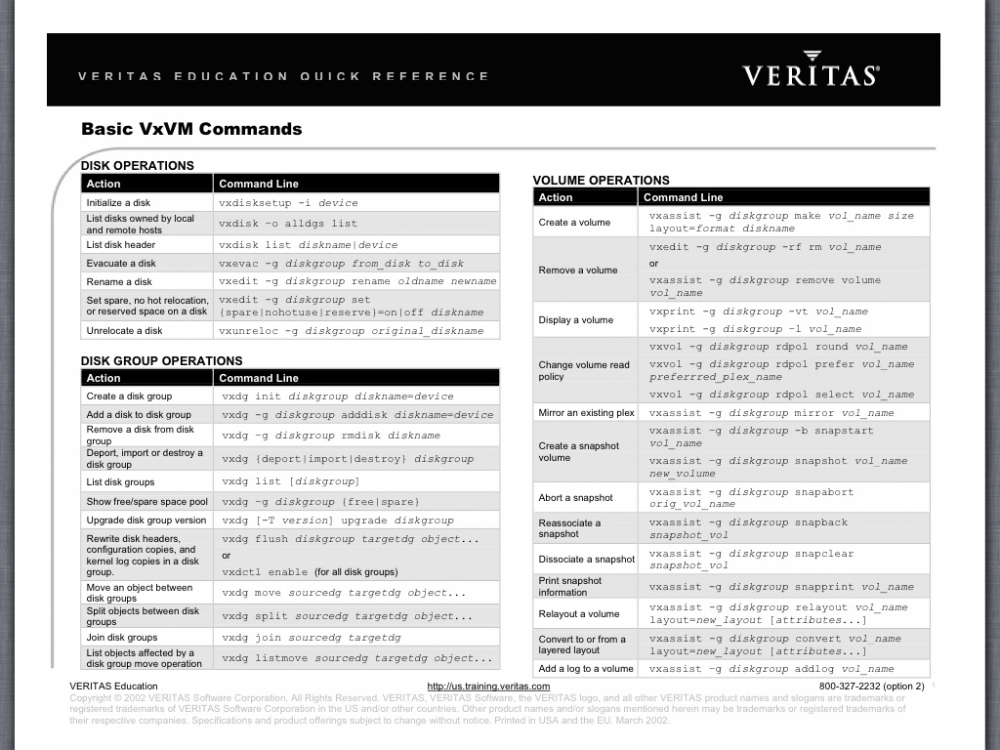vxassist [-g diskgroup] mirror \
volume [attributes]
|
Adds a mirror to a volume.
Example:
# vxassist -g mydg mirror \
myvol mydg10
|
vxassist [-g diskgroup] remove \
mirror volume [attributes]
|
Removes a mirror from a volume.
Example:
# vxassist -g mydg remove \
mirror myvol \!mydg11
|
Note: The ! character is a special character in some shells. This example shows how to escape it in a bash shell.
|
|
vxassist [-g diskgroup] \
{growto|growby} volume length
|
Grows a volume to a specified size or by a specified amount.
Example:
# vxassist -g mydg growby \
myvol 10g
|
vxassist [-g diskgroup] \
{shrinkto|shrinkby} volume length
|
Shrinks a volume to a specified size or by a specified amount.
Example:
# vxassist -g mydg shrinkto \
myvol 20g
|
vxresize -b -F vxfs [-g diskgroup] \
volume length diskname ...
|
Resizes a volume and the underlying Veritas File System.
Example:
# vxresize -b -F vxfs \
-g mydg myvol 20g mydg10 \
mydg11
|
vxsnap [-g diskgroup] prepare volume \
[drl=on|sequential|off]
|
Prepares a volume for instant snapshots and for DRL logging.
Example:
# vxsnap -g mydg prepare \
myvol drl=on
|
vxsnap [-g diskgroup] make \
source=volume\
/newvol=snapvol\
[/nmirror=number]
|
Takes a full-sized instant snapshot of a volume by breaking off plexes of the original volume.
Example:
# vxsnap -g mydg make \
source=myvol/\
newvol=mysnpvol/\
nmirror=2
|
vxsnap [-g diskgroup] make \
source=volume/snapvol=snapvol
|
Takes a full-sized instant snapshot of a volume using a prepared empty volume.
Example:
# vxsnap -g mydg make \
source=myvol/snapvol=snpvol
|
vxmake [-g diskgroup] cache \
cache_object cachevolname=volume \
[regionsize=size]
|
Creates a cache object for use by space-optimized instant snapshots.
A cache volume must have already been created. After creating the cache object, enable the cache object with the vxcache start command.
For example:
# vxassist -g mydg make \
cvol 1g layout=mirror \
init=active mydg16 mydg17
# vxmake -g mydg cache cobj \
cachevolname=cvol
# vxcache -g mydg start cobj
|
vxsnap [-g diskgroup] make \
source=volume/newvol=snapvol\
/cache=cache_object
|
Takes a space-optimized instant snapshot of a volume.
Example:
# vxsnap -g mydg make \
source=myvol/\
newvol=mysosvol/\
cache=cobj
|
vxsnap [-g diskgroup] refresh snapshot
|
Refreshes a snapshot from its original volume.
Example:
# vxsnap -g mydg refresh \
mysnpvol
|
vxsnap [-g diskgroup] dis snapshot
|
Turns a snapshot into an independent volume.
Example:
# vxsnap -g mydg dis mysnpvol
|
vxsnap [-g diskgroup] unprepare \
volume
|
Removes support for instant snapshots and DRL logging from a volume.
Example:
# vxsnap -g mydg unprepare \
myvol
|
vxassist [-g diskgroup] relayout \
volume [layout=layout] \
[relayout_options]
|
Performs online relayout of a volume.
Example:
# vxassist -g mydg relayout \
vol2 layout=stripe
|
vxassist [-g diskgroup] relayout \
volume layout=raid5 \
stripeunit=W \
ncol=N
|
Relays out a volume as a RAID-5 volume with stripe width W and N columns.
Example:
# vxassist -g mydg relayout \
vol3 layout=raid5 \
stripeunit=16 ncol=4
|
vxrelayout [-g diskgroup] -o bg \
reverse volume
|
Reverses the direction of a paused volume relayout.
Example:
# vxrelayout -g mydg -o bg \
reverse vol3
|
vxassist [-g diskgroup] convert \
volume [layout=layout] \
[convert_options]
|
Converts between a layered volume and a non-layered volume layout.
Example:
# vxassist -g mydg convert \
vol3 layout=stripe-mirror
|
vxassist [-g diskgroup] remove \
volume volume
|
Removes a volume.
Example:
# vxassist -g mydg remove \
myvol
|


Be the first to comment.
Leave a response